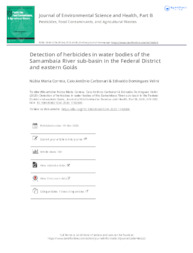Detection of herbicides in water bodies of the Samambaia River sub-basin in the Federal District and eastern Goiás.
Detection of herbicides in water bodies of the Samambaia River sub-basin in the Federal District and eastern Goiás.
Autoria: CORREIA, N. M.; CARBONARI, C. A.; VELINI, E. D.
Resumo: The objective of this study was to identify and quantify herbicide residues in water samples of rain, cisterns, streams, ponds, springs, semi-artesian wells, dams and a river in the Rio Samambaia sub-basin in the Federal District and eastern Goiás. A total of 287 samples were collected from 20 farms in the sub-basin in the rainy (February, summer) and dry (August, winter) seasons in 2016. Aminomethylphosphonic acid (AMPA, a glyphosate metabolite), clethodim, chlorimuron-ethyl, diuron, fluazifop acid (a fluazifop-p-butyl metabolite and the active ingredient), haloxyfop acid (a haloxyfop-methyl metabolite and the active ingredient), imazamox, mesotrione, metsulfuron, nicosulfuron and pendimethalin were not identified in any water sample. In the rainy season, approximately 99% of the samples contained residues at least one of the evaluated herbicides; in the dry season (, 100% of the samples contained residues of at least one of the evaluated herbicides. When considering only detection frequency, metribuzin, atrazine, clomazone and haloxyfop-methyl were the main herbicides found in the water of the Samambaia River sub-basin. In turn, based on levels higher than the limit of quantification, the main compounds detected were atrazine, clomazone, haloxyfop-methyl and glyphosate. In both seasons, the highest relative concentrations of herbicides for the rainy and dry seasons were found in spring water, 25% and 56%, respectively, and dam water, 23% and 16%, respectively.
Ano de publicação: 2020
Tipo de publicação: Artigo de periódico
Unidade: Embrapa Cerrados
Palavras-chave: Cisterna, Contaminação, Herbicida, Recurso Hídrico, Água
Observações
1 - Por padrão são exibidas publicações dos últimos 20 anos. Para encontrar publicações mais antigas, configure o filtro ano de publicação, colocando o ano a partir do qual você deseja encontrar publicações. O filtro está na coluna da esquerda na busca acima.
2 - Para ler algumas publicações da Embrapa (apenas as que estão em formato ePub), é necessário ter, no celular ou computador, um desses softwares gratuitos. Sistemas Android: Google Play Livros; IOS: iBooks; Windows e Linux: software Calibre.
Acesse outras publicações
Acesse a Base de Dados da Pesquisa Agropecuária (BDPA) para consultar o acervo completo das bibliotecas da Embrapa.

